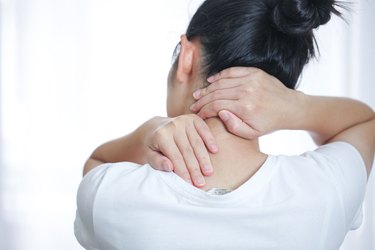
Muscle spasms are commonly felt as a physiological response to overexertion, fatigue or pain and can be treated with neck spasm exercises. However, sometimes muscle spasms are indicative of a more severe condition.
The Causes of Muscle Spasms
Video of the Day
Muscle spasms are defined as a sudden involuntary contraction of one or multiple muscles. These muscle spasms are often painful and can result from unnaturally continuous muscle contraction, according to the North American Spine Society.
Video of the Day
Either smooth muscles or skeletal muscles of the limbs and spine can be involved in muscle spasms. The muscles of the neck, also known as the cervical muscles, are skeletal muscles.
Cervical muscle spasms can occur with a muscle injury or overuse. For example, if you have not warmed up appropriately before exercise. Muscle spasms can also happen if you do not have a proper electrolyte balance and are depleted of essential nutrients. In this case, muscle spasms can be treated with rest, gentle stretching and adequate hydration and nutrition.
If your cervical muscle spasms are chronic, meaning that they continue for a long time, then there may be a more serious medical issue. Persistent muscle spasms can be due to hormonal problems, nutritional deficiencies, vascular or toxic metabolic issues, as explained by the North American Spine Society.
Underlying neurological diseases such as spinal stenosis or a major disc herniation can interfere with signals from nerves to the spinal cord and cause muscle spasms. If you experience chronic muscle spasms, be sure to speak to a healthcare provider.
Cervical Muscle Spasm Exercises
According to an October 2014 article published in the Open Orthopedics Journal, treatment for neck pain and spasms traditionally includes rest, physiotherapy, manual therapy and strengthening exercises.
A December 2015 article published in the Annals of Rehabilitation Medicine concluded that a combination of stretching and strengthening exercises could help reduce muscle spasms caused by neck pain.
The study participants performed a program that consisted of walking for two hours in the forest every morning for five days, as well as an exercise program containing a 10-minute warm-up, 30 minutes of exercise and a 10-minute cool down.
The warm-up consisted of light full-body stretching, including the cervical and shoulder region. Stretching and strengthening exercises focusing on cervical and shoulder areas comprised the main activity. The cool down exercise involved only stretching.
Significant improvement occurred as a result of this program, showing a substantial reduction in the number of pain trigger points in the posterior neck region.
Although the exact exercises performed in this study are not provided, a similar review published in May 2013 in the Journal of Physical Therapy Science on high school students' neck pain, including spasms, provides neck muscle spasm stretches. This study showed significant improvement compared to the control group who did not perform the exercises.
Seven-Step Neck Muscle Training
The neck muscle training stretch provided to the study participants included seven motions. Increase the time spent holding each stretch by two to three seconds every two to three days until you reach 25 seconds.
- With hands clasped, stretch your arms straight upward while looking at your hands hold this for 10 seconds.
- Place your hands on your shoulders and push out your chest with your head tilted backward.
- Slowly turn your head horizontally while looking straight in front of you and stop when you've reached your full range of motion. Repeat on both the right and the left side.
- Throwing back your head, turn it until it has reached the fully stretched point. Repeat on the right and left side.
- Lower your head and turn it until it has reached its full range of motion. Repeat on the right and left side.
- Place one of your hands over your shoulder and grasp the elbow of the turned hand with the other hand over the head and slowly pull it inward until it has reached the fully stretched point. Repeat for the right and the left side.
- Straighten the upper part of your body and slowly raise both of your arms with your hands clasped.
- Open Orthopaedics Journal: "Chronic Neck Pain: Making the Connection Between Capsular Ligament Laxity and Cervical Instability"
- North American Spine Society: "Muscle Spasms"
- Journal of Physical Therapy Science: "Effects of Neck Exercise on High-School Students’ Neck–Shoulder Posture"
- Annals of Rehabilitation Medicine: "Relief of Chronic Posterior Neck Pain Depending on the Type of Forest Therapy: Comparison of the Therapeutic Effect of Forest Bathing Alone Versus Forest Bathing With Exercise"
Is this an emergency? If you are experiencing serious medical symptoms, please see the National Library of Medicine’s list of signs you need emergency medical attention or call 911.